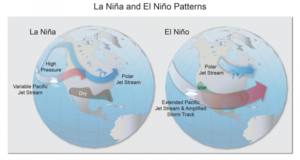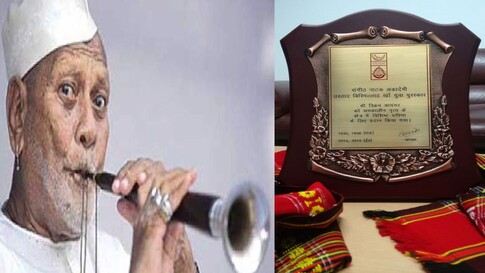El Niño La Niña and changing weather patterns (GS Paper 1, Geography)

Why in news?
- A new study projects that climate change will significantly impact El Niño-La Niña weather patterns approximately by 2030.
Details:
- El Niño and La Niña are atmospheric patterns that influence warming and cooling of sea surface temperatures in the Central and Equatorial Pacific. The two opposing patterns occur in an irregular cycle called the El Niño Southern Oscillation (ENSO) cycle.
- The study used mathematical models that analysed sea surface temperature (SST) from 1870 to 2019 to observe ENSO and make predictions.
- Earlier in 2022, the World Meteorological Organisation predicted the first “triple dip” La Niña of the century, spread over three consecutive northern hemisphere winters. Meteorology centres worldwide have confirmed that we are indeed in one at present.
- This is only the third time since 1950 that a triple dip La Nina has been observed.
Key findings:
- According to the study, increased SST variability from ENSO in the eastern Equatorial Pacific (EP) will emerge around 2030 ( error margin of +/- 6 years), more than a decade earlier than that of the central Pacific ENSO.
- If CP and EP are not separated, SST variability from ENSO will occur almost four decades earlier than previously suggested. Changes in the equatorial Pacific will be visible first due to a stronger increase in EP-ENSO rainfall response, leading to increased SST variability.
El Niño phenomenon:
- El Niño is the warming of sea waters in Central-east Equatorial Pacific that occurs every few years.
- During El Niño, surface temperatures in the equatorial Pacific rise, and trade winds weaken. Normally, easterly trade winds blow from the Americas towards Asia. Due to El Niño, they falter and change direction to turn into westerlies, bringing warm water from the western Pacific towards the Americas.
- Deeper waters are usually more nutrient-rich, but upwelling (where deeper waters rise towards the surface) is reduced under El Niño, in turn reducing phytoplankton off the coast.
- Fish that eat phytoplankton are affected, followed by other organisms higher up the food chain. Warmer water also carries tropical species towards colder areas, disrupting multiple ecosystems.
- Heat redistribution on the surface impacts airflows above the ocean. While easterly winds are dry and steady, Pacific westerlies are warmer and moister.
- Since the Pacific covers almost one-third of the earth, changes in its temperature and subsequent alteration of wind patterns disrupt global weather patterns.
Global impact:
- El Niño is a loose translation of “little boy” or even “Christ child” in Spanish. South American fishermen are believed to have noticed unusually warm water in the Pacific Ocean in the 1600s. Earlier, it was also called “El Niño de Navidad,” since it peaks around December.
- El Niño causes dry, warm winter in Northern U.S. and Canada and increased flooding risk on the U.S. gulf coast and southeastern U.S. It also brings drought to Indonesia and Australia.
What is La Niña?
- La Niña, or “the girl/little girl”, is the opposite of El Niño.
- La Niña sees cooler than average SST in the equatorial Pacific region. Trade winds are stronger than usual, pushing warmer water towards Asia. On the American west coast, upwelling increases, bringing nutrient-rich water to the surface.
- Pacific cold waters close to the Americas push jet streams northwards. This leads to drier conditions in Southern U.S., and heavy rainfall in the northwest and Canada. La Niña also makes winter temperatures warmer in the south and cooler to the north of the U.S.
Floods in Australia:
- La Niña has also been associated with heavy floods in Australia.
- Two successive La Niña events in the last two years caused intense flooding in Australia, resulting in significant damage.
- Parts of Australia are battling floods this year for the third year in a row, even as scientists hope La Niña will be relatively shorter in 2022.
El Niño Southern Oscillation:
- The combination of El Niño, La Niña, and the neutral state between the two opposite effects is called the El Niño Southern Oscillation (ENSO). Southern oscillations are large-scale changes in sea level pressure in the tropical Pacific region.
- The phenomenon was discovered by Sir Gilbert Walker, who was researching the drought in India in the early 20th century and found an alternating variation in pressure between the eastern and western Pacific Ocean.
- He found that when pressure was high at Darwin, Australia (western Pacific) it was low at Tahiti (eastern Pacific), and vice-versa. However, it was only in the late 1960s that Norwegian meteorologist Jacob Bjerknes and others convincingly linked this with El Niño.
Impact on India’s monsoons:
- In India, El Niño causes weak rainfall and more heat, while La Niña intensifies rainfall across South Asia, particularly in India’s northwest and Bangladesh during the monsoon.
- At present, India too is witnessing an extended triple dip La Niña. This, in part, is why India saw surplus rain in September, a month that usually sees the monsoon retreat, for the third year in a row.
Supreme Court seeks govt response on including same-sex marriage under Special Marriage Act
(GS Paper 2, Judiciary)
Why in news?
- Recently, the Supreme Court sought the government’s response to pleas to allow solemnisation of same-sex marriage under the Special Marriage Act.
- The Special Marriage Act of 1954 provides a civil form of marriage for couples who cannot marry under their personal law.
Background:
- A Bench of Chief Justice of India D.Y. Chandrachud and Justice Hima Kohli agreed to hear partners Supriyo @ Supriya Chakraborty and Abhay Dang, who said the non-recognition of same sex marriage amounted to discrimination that struck at the root of dignity and self-fulfillment of LGBTQ+ couples.
- The Bench issued separate notices to the Union of India and the Attorney General of India and listed the case for hearing after four weeks.
- It transferred various pending issues before various High Courts, including in Kerala and Delhi, to itself.
Section 377:
- The Supreme Court had decriminalised homosexuality in 2018, urging the LGBTQ+ community to forgive history for their “brutal” suppression.
- A five-judge Constitution Bench had unanimously held that criminalisation of private consensual sexual conduct between adults of the same sex under Section 377 of the Indian Penal Code was clearly unconstitutional.
- It had declared the 156-year-old “tyranny” of Section 377 as “irrational, indefensible and manifestly arbitrary”. Section 377 punished homosexuality with a 10-year imprisonment.
Ustad Bismillah Khan Yuva Puraskar for the years 2019, 2020 & 2021
(Miscellaneous)
Why in news?
- Recently, the Sangeet Natak Akademi, the National Academy of Music, Dance and Drama selected 102 (Including three joint Awards) artists of India who have made a mark as young talents in their respective fields of the performing arts for the Ustad Bismillah Khan Yuva Puraskar for the years 2019, 2020 & 2021.

Akademi Fellows:
- The National Academy of Music, Dance and Drama elects eminent personalities in the field of performing arts as Akademi Fellows.
- The award of Akademi fellow carries a prize money of Rs three lakh while the Akademi award carries a prize money of Rs one lakh, besides a 'tamrapatra' and 'angavastram'.
- With the election of ten fellows, there are presently 39 fellows of Sangeet Natak Akademi
- The fellows are: Bharatnatyam dancer Saroja Vaidyanathan, Kathakali exponent Sadanam Krishnan Kutty, Manipuri dancer Darshana Jhaveri, classical vocalist Chhannu Lal Mishra, Carnatic clarinet player AKC Natarajan, tabla player Swapan Chaudhuri, classical singer Malini Rajurkar, Carnatic and Hindustani musician TV Gopalakrishnan, folk singer Teejan Bai, and musicologist Bharat Gupt.
Akademi Puraskar:
- The general council of Sangeet Natak Akademi also selected 128 artists from the field of Music, Dance, Theatre, Traditional/Folk/Tribal Music/Dance/Theatre, Puppetry and Overall contribution/scholarship in the performing arts for the Akademi Puraskar for the years 2019, 2020 and 2021.
- The 128 artists include three joint awards.
- The eminent artists cover the entire gamut of the performing arts such as
- Hindustani and Carnatic vocal music,
- Hindustani and Carnatic instrumental music, Sugam Sangeet as well as Harikatha;
- The major forms of Indian dance.
About Ustad Bismillah Khan Yuva Puraskar:
- The Ustad Bismillah Khan Yuva Puraskar, given to artists below the age of 40 years, was introduced with the objective of identifying and encouraging outstanding young talents in diverse fields of performing arts and giving them national recognition early in their life, so that they may work with greater commitment and dedication in their chosen fields.
- The Ustad Bismillah Khan Yuva Puraskar carries a purse money of Rs. 25,000/- (Rupees twenty-five thousand only).
- The Yuva Puraskar will be presented at a special ceremony by the Chairman, Sangeet Natak Akademi.



